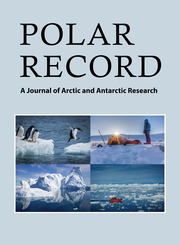No CrossRef data available.
Article contents
The first publication of The South Polar Times, Volume IV
Published online by Cambridge University Press: 22 May 2013
Extract
Polar bibliophiles, librarians and readers will be familiar with the three handsome facsimile volumes of the first Antarctic newspaper, published in 1907 and 1914 and edited in turn by E. Shackleton, L.C. Bernacchi and A. Cherry-Garrard during the National Antarctic Expedition, 1901–1904 and the British Antarctic Expedition 1910–1913. These expeditions were led by Captain R.F. Scott R.N. in Discovery and Terra Nova respectively. From S.Y. Discovery, beset for two winters in the ice of McMurdo Sound were made the first extensive sledge journeys into the interior of the Antarctic continent, including the great ice sheet or plateau. These were further prolonged, following Shackleton's Nimrod expedition, while the pursuit of science during both Scott expeditions led to the publication in London of two monumental sets of scientific and geographical results, plus new charts and maps.
Information
- Type
- Notes
- Information
- Copyright
- Copyright © Cambridge University Press 2013

